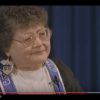KJIPUKTUK (Halifax) – Walking With Our Sisters, a commemorative project honouring missing and murdered Indigenous women, girls and Two-Spirited individuals, officially opened its doors to the public on Saturday.
Hosted by the Art Gallery at Mount Saint Vincent University in Halifax, the project displays more than 1,800 carefully hand-crafted moccasin tops (known as vamps) around the room, each one representing an individual life that has been lost recently or in a distant past.
“We have people following the faces of the vamps, so you’re walking with them. You’re walking with the sisters, with the mothers and the aunts and the two-spirited individuals we have lost,” says Kehisha Wilmot, a volunteer and designated keeper at the memorial.
“The vamps are unfinished, and the reason that they’re unfinished is their lives were cut short. They didn’t get to live their lives fully, therefore we use vamps to represent that.”
Michele Graveline, a member of the Walking With Our Sisters event organizing committee, says that Walking With Our Sisters is not an exhibit, but rather it is a memorial.
“It’s a very moving experience to walk with our sisters,” says Graveline. “It brings music, it brings the art of the vamps and it brings ceremony together.”
Upon entering the space, participants must follow traditional protocol such as removing their shoes and being smudged upon entry. Then people are asked to pick up a small pouch with tobacco inside it to carry around with them while they walk around the room, and then leave behind for the keepers to burn at the end of the night in ceremony.
“The tobacco ties help carry our prayers,” Graveline explains.
“Most people may hear about a woman going missing, or see it on a poster one time or hear it on the news—if it gets to the news, it doesn’t always. And some families work really hard to get images of their loved ones out there, but I don’t think people grasp the magnitude of it until they see those vamps laid, and they take a walk with the sisters.”
For Graveline, the beauty of the vamps is representative of the women’s lives.
“They were lights, even if their life circumstances were such, and often times that’s what was focused on, and there’s disregard for these women. But in there, that’s taken away, and they’re together, and the light shines there.”
One visitor, Joe Michael, a retired RCMP officer and member of the Shubenacadie First Nations community, says he’s attending the memorial to honour his family members who had gone missing.
“In 1936, my grandmother and her husband, and my grandmother’s sister and her husband, went to sell their crafts up in Cape Breton,” he says. “It was supposed to be a day trip—they go there and they come back. When they left the shores of Eskasoni to go to Big Pond, that was it.”
Michael says that the media at the time reported that his missing grandparents and great aunt and uncle had drowned, and no police investigation was ever launched. However when Michael’s ancestors did their own search, they never found any bodies to prove that theory, so the late Elders Greg Johnson and Charlie Morris took the investigation into their own hands. Three years ago, after having worked on the case for 45 years, Johnson contacted Michael and asked him to join in the investigation.
“I kind of knew a little about it, and I said I would, so I worked with him for a while,” Michael says. The duo kept at it until Johnson passed away from cancer, not long after they started working together.
After Johnson died, Morris contacted Michael and told him he, too, was sick with cancer.
“I went to visit him, and two days later he passed,” Michael says. “So I continued on.”
Michael says that after separating the facts from the fiction and hearsay, he put the facts together and figured what happened: that his family members did not drown but were actually murdered.
“Can I point (a) finger at nobody? No, I’m not into that. I know what happened to them and I know where they’re at,” Michael says.
To promote healing and help bring closure to the family, the Eskasoni community held ceremonies to honour Michael’s late family members.
“We had bringing home the spirits and releasing the spirits back to Eskasoni the community, and we had services by the Elders,” he says.
For Michael, the memorial is important because it helps spread awareness about the issue of missing and murdered Indigenous people in Atlantic Canada and beyond. It gives those whose loved ones have been taken a place to grieve and remember, but also it gives those who are still waiting for answers and healing a space to be supported by their community.
But most of all, for Michael, the memorial should serve as a useful reminder for Indigenous youth to be careful and make smart choices.
“We have to teach our youth now … Don’t be trapped in that web of easy roads,” he says. “Because all of the sudden, you could be the vamps laid out on the floor right now.”
The Walking With Our Sisters memorial will be at the Art Gallery at Mount Saint Vincent University until February 1, 2017, and after that the tour will continue across Canada and the United States. For more information, visit walkingwithoursisters.ca.
If you can, please support the Nova Scotia Advocate so that it can continue to cover issues such as poverty, racism, exclusion, workers’ rights and the environment in Nova Scotia.



